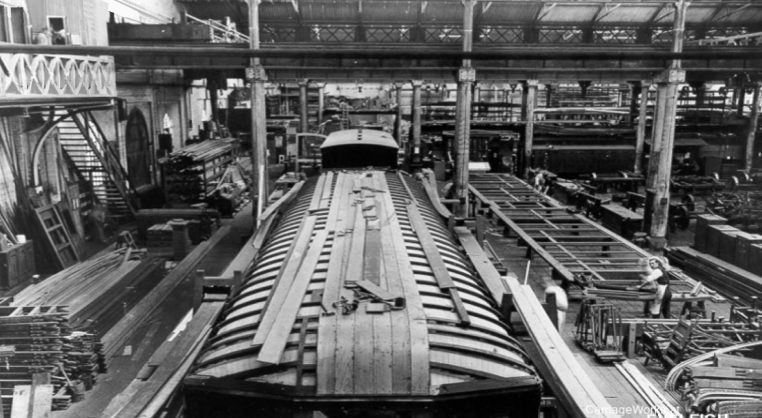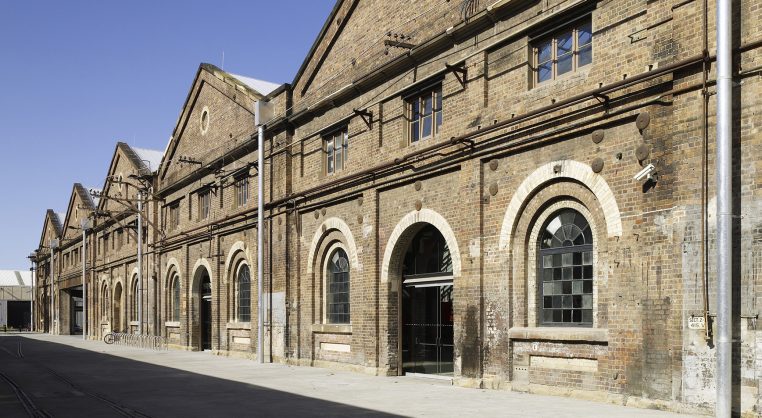Carriageworks is a contemporary performing arts centre for theatre, experimental dance and acrobatic theatre housed in the former Eveleigh Carriage Workshops, adjacent to Sydney’s main rail corridor. It was developed by ArtsNSW and the Staterail Authority with a brief for “an engaging centre for professional, emerging and aspiring contemporary artists, a profitable base for the arts industry and its commercial partners, a dynamic neighbourhood venue for locals and an exciting and unique arts space for visitors.”
A series of freestanding, acoustically isolated, concrete containers are inserted into the vast interior of the workshops, leaving the majority of the building envelope and spatial structure intact.
The project was staged to accommodate the limited budget and the desire for the new facility to grow organically over time. Bays 16-20 were fitted out as the performing arts centre, Bay 21 has been redeveloped as a major art gallery, and the remaining four bays are expected to be completed within ten years.
Download a printable version of the Carriageworks Case Study (PDF 365 KB).
Site history and heritage
The Carriage Workshops are part of the Eveleigh Railway Complex, which is highly significant as a large, intact, high quality workshop site from Australia’s steam era. The workshops are also historically significant for their contribution to the development of surrounding suburbs and their seminal role in many major
industrial strikes.
Built in early 1880s to a design by Chief Engineer George Cowdry, the complex provided a government-owned maintenance facility for the rapidly growing state rail network.
Carriages moved through the building along tracks from Bay 16 to Bay 25. Each bay had a different function – from fundamental structural repairs in Bay 16 to final trimming and upholstery works in Bay 25. Long vistas could be had in both directions throughout the working life of the building.
The workshops closed in 1988. When the adaptive reuse project was initiated in 2004 the building was mostly intact, but it was run down, covered in graffiti and in desperate need of maintenance. Ancillary machinery, such as the line shafting that powered machinery, rails and cranes, remained. The CarriageWorkshops are listed on the NSW Heritage Register.
Opportunities
The enormous, cathedral-like spaces of workshop had few dividing walls and plenty of natural light. Beyond the fabric – ornate brickwork, elegant cast-iron columns and slender steel trusses – the architects saw great potential in the workshop’s spatial qualities, which they saw as echoing a bygone era and the building’s past uses.
Challenges
The workshop building was covered in dust with a high lead content, painted surfaces contained lead and some of the fill below ground was contaminated. The building was very noisy and vibrated as the trains sped past.
Approach and outcome
New spaces were inserted into the vast workshops in a manner that kept the spatial qualities, structure and experience of the original building. The historic building was maintained and stabilised, keeping traces of previous uses and activities.
The original building was barely touched, apart from removing and raising part of the iron and steel roof to accommodate the height required for the main theatre. Historic machinery, including overhead cranes and line shafting, was retained and painted signs and patina were left, indicating the building’s age and former use.
Parts of the historic fabric that were removed have been relocated and reused. For example, roof trusses removed to accommodate the height of the large theatre now form an entry structure on the Wilson Street entrance.
The new theatre and rehearsal spaces are housed in rectilinear, acoustically isolated, insitu concrete containers. These pale grey boxes are sited to respond to the workshop’s original planning and use. Placed parallel to the existing structural grid, they float free of the heritage structure (except at the bounding walls where they are clearly articulated). Reconstructed historic skylights have been carefully located to cast shadows on the pale grey concrete walls of these new theatre boxes.
The planning strategy works with an idea of non-hierarchical space – this meets the performers’ desire to avoid the hierarchical structure of traditional theatre, while also maintaining the unimpeded vistas through the building. A new foyer runs along the length of the building and theatre entries are designed to recall the carriages that once passed through the space.
The adaptive reuse includes upgrades to protect the heritage values of the buildings and to make them compliant with the Building Code of Australia.
Necessary conservation and repairs included works to the roof, brick and stone walls, windows and doors. The cast and wrought iron roof columns and trusses were treated to prevent further rust. All services needed replacing. Where elements were deemed of high or exceptional significance they were faithfully reconstructed based on physical evidence and historic drawings.
Lessons
- The project has achieved the conservation of a large scale but run down public asset.
- The spaces and social history of the place were understood as being as important as the building fabric.
- Striking new elements are inserted in a way that responds to the planning and spatial logic and experience of the building, as well as its material qualities.
- Building fabric is stabilized and left intact wherever possible, maintaining its patina and memory.
Project team
Architect: Tonkin Zulaikha Greer. Client: Arts NSW and StateRail. Heritage architects:
Otto Cserhalmi and Partners. Project manager: Root Projects. Quantity surveyor: Currie and Brown. Structural engineer: Simpson Design. Services engineer: Bassett Consulting Engineers. Hydraulics engineer: Warren Smith and Partners. Acoustics engineer: Arup Acoustics. BCA advisor: City Plan Services. Fire engineer: Defire. PCA: Advance Building Approvals. Access: Accessibility Solutions. Theatre and lighting consultant: Bluebottle. Graphic designer: Jelly Design. Community consultation: Australia Street Company.
References
John de Manincor “CarriageWorks”, Architecture Australia 96 no 4 (July/August 2007).
Joe Rollo, “CarraigeWorks”, C+A 6.
Naomi Stead, “Back on Track” Monument 87 (2008).
Stephen Ward, “Breathing Life into the Corpse: Upcycling through adaptive reuse” in Designing for Zero Waste: Consumption, technologies and the built environment, ed Steffen Lehman and Robert Crocker (London: Earthscan, 2012).



